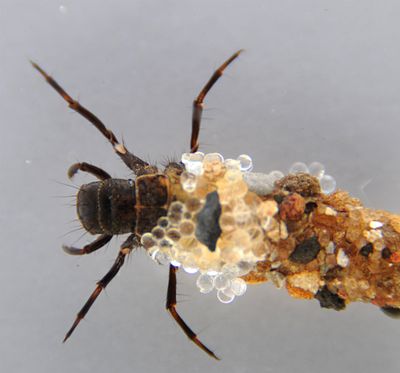Out & About: Caddis fly case is sticky subject

OUTSTUDY – They’re known as cased caddis, rock rollers or periwinkles to kids probing rocky streams and fly fishermen who imitate caddis flies in their various life stages to catch trout.
But these silk and sand-cased larvae may rise to an even higher calling.
A University of Utah study has pinpointed why the silk spun by caddis fly larvae remains sticky underwater, suggesting that one of nature’s most remarkable adhesives could someday be replicated for surgical use.
The insects begin life in streams, using larval silk to bond grains of sand into protective cocoons.
“Gluing things together underwater is not easy,” said Russell Stewart, an associate professor of bioengineering. “Have you ever tried to put a Band-Aid on in the shower? This insect has been doing this for 150 million years.
“I picture it as sort of a wet Band-Aid, maybe used internally in surgery, like using a piece of tape to close an incision as opposed to sutures.”
Researchers began their study in Utah trout streams, examining Brachycentrus echo, one of thousands of caddis fly species, which belong to an order related to butterflies and moths.
Bucket brigade weak on fish science
OUTCRY – Illegal fish introductions continue to raise havoc with fisheries management in the Idaho Panhandle.
Not content with a few good northern pike fisheries, some people are transporting the predators to other waters and releasing them without concern for the consequences.
In recent years, pike have turned up from unauthorized releases in Hauser, Spirit, Bonner, Fernan and Rose, not to mention Liberty and Newman in Washington.
Feeling low while climbing high?
OUTPACE – Altitude sickness is not limited to climbers.
Hikers and skiers can suffer high-altitude pulmonary edema (HAPE) — a potentially fatal lung condition — which may occur more frequently at moderate altitude than past research has indicated.
A very fit Spokane Mountaineer with many miles of experience says she suffered from mild HAPE last week in the Eagle Cap Wilderness.
A study published in CHEST, the peer-reviewed journal of the American College of Chest Physicians, suggests that HAPE may regularly occur at 8,000 feet above sea level, affecting young, healthy skiers and hikers.
HAPE involves increase in lung blood pressure followed by fluid buildup in the lungs. Symptoms include labored breathing and abnormal breathing sounds, often around he second day at altitude. Fluid buildup can follow in the lungs.
Headaches, digestive troubles and problems sleeping can be other signs of altitude sickness. If it progresses, shortness of breath, coughing and pneumonia-like signs are common. Mental disorientation can occur, meaning people may not realize they are in trouble.
Most at risk: People who come from low elevation and head to high country fast. HAPE is more common in men.
Best cure in the early stages: Descend to a lower elevation.
Prevention involves gradually moving to higher elevations, or climbing high by day and sleeping low, and staying well-hydrated.